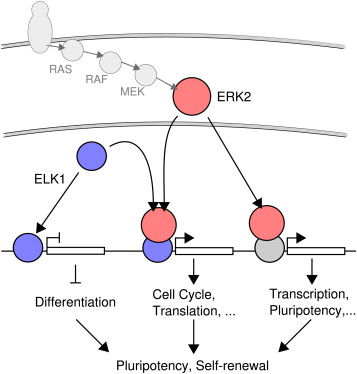博文
Mol Cell封面文章
|||

Commons:
On the cover: In this issue, Goke, et al. (844–855) study the genome-wide chromatin interactions of the kinase ERK2 in human embryonic stem cells (hESCs). The interactions are part of a larger network, visualized on the cover as the railway system of Singapore. Each railway line represents a protein that interacts with chromatin. Protein-protein interactions are depicted as interchanges. ERK2 (red line) colocalizes with the transcription factor ELK1 (purple line) and with polymerase II (yellow line) at actively transcribed promoters ([ERK2+ELK1]-binding module). In the absence of ERK2 at the DNA, ELK1 colocalizes with the Polycomb group proteins (EZH2, green line) at repressed developmental genes ([ELK1]-module). Additional interactions with other proteins such as SUZ12 and MEK are indicated by additional interchanges in the map.
Summary:
The extracellular signal-regulated kinase (ERK)/mitogen-activated protein kinase signal-transduction cascade is one of the key pathways regulating proliferation and differentiation in development and disease. ERK signaling is required for human embryonic stem cells’ (hESCs’) self-renewing property. Here, we studied the convergence of the ERK signaling cascade at the DNA by mapping genome-wide kinase-chromatin interactions for ERK2 in hESCs. We observed that ERK2 binding occurs near noncoding genes and histone, cell-cycle, metabolism, and pluripotency-associated genes. We find that the transcription factor ELK1 is essential in hESCs and that ERK2 co-occupies promoters bound by ELK1. Strikingly, promoters bound by ELK1 without ERK2 are occupied by Polycomb group proteins that repress genes involved in lineage commitment. In summary, we propose a model wherein extracellular-signaling-stimulated proliferation and intrinsic repression of differentiation are integrated to maintain the identity of hESCs.

☆ ERK2 Is Required for Maintaining the hESC Identity
☆ Genome-wide Kinase-Chromatin Interactions Identify Transcriptional Targets of ERK2 Signaling
☆ ERK2 Targets Noncoding Genes and Genes Involved in Metabolism, Cell Cycle, and Transcription.
☆ Motif Finding Identifies Candidate Interaction Partners of ERK2
☆ ERK2 Co-occupies Promoters Bound by the Transcription Factor ELK1 in hESCs
☆ ERK2 Colocalization with ELK1 Discriminates between Activation and Repression
☆ The [ERK2], [ERK2ELK1], and [ELK1] Modules Are Bound by Distinct Combinations of Transcription Factors and Chromatin Regulators
https://wap.sciencenet.cn/blog-982855-703730.html
上一篇:最新piRNA review
下一篇:Gene&Dev关于meiosis新文
全部作者的其他最新博文
- • 一个悲伤的故事
- • 我怀念的
- • 巴德年院士科大报告语摘——受益匪浅
- • 这是个黑童话么?——MC封面文章
- • 你是猴子请来的啥?